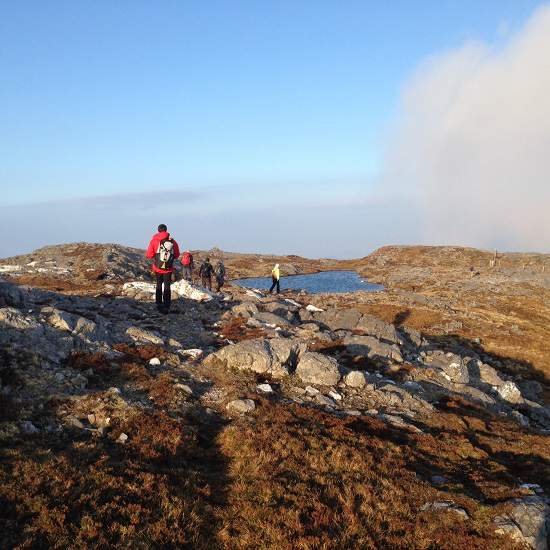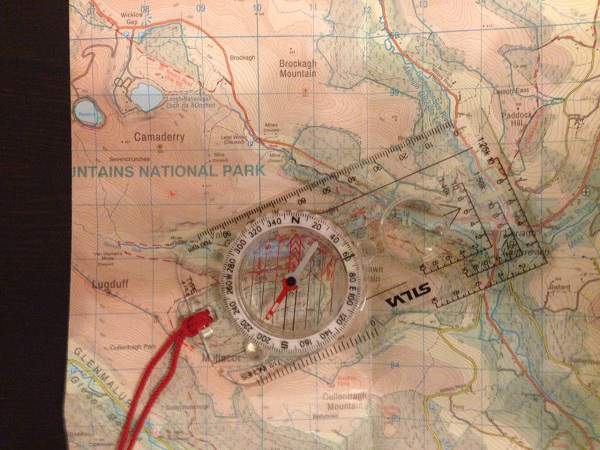When you go out hiking you’re going out into terrain in the wilderness. With that in mind, there are certain steps you can take to ensure you have as enjoyable an experience as possible.

While whole books can be, and are, written about hiking in safety, I thought a quick summary post with ten of, what I think, are the main tips you can easily implement to help keep you safe on your adventures out on the trail would be useful.
Every point below is applicable and so I am loathe to put these in any particular order of importance. In short, you need to tend to all of them on any hike you are preparing to undertake.
#1 Wear the Right Gear
This first one is probably one of the ones that is most often neglected. In this day and age, good gear is easily available and while it can be very expensive, there are plenty of reasonable options at reasonable prices available too.
Every other week when I go out hiking, I’m half way up a mountain and I see someone in Nike Air sneakers and jeans. Not advisable in any way. Although trail shoes can be grand on occasion as a general rule I recommend you have proper hiking boots.
As well as that, some kind of breathable warm clothing is advised so base layers (where required) hiking pants, tee’s, etc. should allow you to sweat but let excessive heat out and away from your skin to prevent moisture build up.
You also need to have layers for warmth so a fleece is a good option.
Finally, you need waterproof outer rain gear, so a rain jacket and rain pants. By this I mean stuff you slip on over your pants and top to protect you from heavy rain.
#2 Carry Additional Layers
As with wearing the right hiking gear, you need to carry any extra that you need. So if it isn’t raining, you should have your waterproofs packed away in your pack. You should also have an extra layer or two for warmth and protection in case it is needed.

I didn’t mention this above, as you don’t really wear it, although you do kind of I guess, but you need to have a good day pack with you, to carry these additional layers and your other bits and pieces in while you’re out on the trail.
#3 Leave your Hiking Route with Someone
A simple yet excellent idea! Before you head out on your hike tell one or two people the following information:
- Where you’re going
- What time you are leaving
- When you expect to be back
Ideally, leave them a print out map of the area where you plan to go hiking with the route marked out on it. That way, if you don’t show up as scheduled, they know where to look for you. Also, be sure to leave it with people who will notice you are gone.
Just knowing where to look is a critical piece of information for any search and rescue teams should you have gotten into difficulty.
#4 Take Adequate Food and Water with you
You need to bring supplies of food and water with you, and it’s always good to bring a little extra just in case something should go wrong. There are of course plenty of options depending on what you like to eat, drink, etc.
For some idea on what I like to do, check out the posts the 10 best day hike foods and how much water should I take on a hike, where I cover what I like to do for my hikes.
#5 Take a Mobile Phone
A mobile phone is a critical piece of safety gear. It’s worth noting that even out of coverage for your network, it should still connect to an emergency number via any available network, as long as it can find one, should you need to.
If you’re hiking in a new area or a country that’s new to you, it’s worth checking before you go out on a hike that you know how to contact help and familiarizing yourself with safety protocols if someone in your party should get hurt.
#6 Have a Map and Compass
At the very least you should have a map of your hike and have an idea how to follow it. Ideally you should be versed with using a compass to take bearings etc. but in reality, that won’t be the case for many.

Take the time to look at your route on your map and pick out landmarks you expect to come across on your way and roughly how long you expect to get to them. That way, if you’re expecting to walk beside a large river in an hours time and you don’t see one, you know you’re off track.
Generally speaking though, if you’re new to hiking, stick to well marked trails which are clearly marked on your map that have easy escape routes back to safety.
#7 Hike with a Group
While I do love to hike solo, I do also enjoy hiking with a group too. The main advantage of hiking with a group in terms of safety? Well, if something happens to one of you, there are enough people to stay with the injured party while others go off to get help should they need to.
Be sure that everyone in the group is of similar fitness so they stay together. If some people are much fitter, a gap will form and people can lose each other, especially in foggy and misty conditions. Not good!
#8 Stay Within your Limits
There are a few points in this with regards to staying safe. Firstly, with regards to fitness, don’t take on something that’s too big a challenge for you. Only you will know your own fitness levels and if you get too far into something very demanding for you, you may not have the strength to walk back out.
As with anywhere, the trail can be a place where macho-ness can come to the fore, especially among men. In short, it’s just daft. If you’re not able for something, better to be honest about it than get yourself into a pickle and have to call for help. Not having the common sense to speak up and stand down from something too challenging for you, is very not macho 🙂 AKA stupid.
The other area of limits are the types of terrain and it’s state when you enter it. For example, if you’re not familiar with hiking in very snowy or boggy conditions, you would be wise to wait to go into that environment with someone who is. You will learn loads in a short space of time and probably save yourself a lot of hassle.
#9 Avoid Hazards
Hazards on the trail, fall into two main categories 1. natural and 2. man made. A natural hazard would be something like a steep cliff. A man made hazard would be an area used for forestry or by the military for shooting practice and man oeuvres.
Again, it’s back to your map and route planning. Most hazards should be highlighted on a good map and so you can plan your route accordingly.
However, many times you may come across a hazard as you hike which you weren’t expecting e.g. a swelled river after heavy rains. Where that occurs, you need to be wise and take appropriate evasive action to avoid the hazard.
#10 Have Emergency Kit with you
Ideally, someone in your party should have a first aid kit and someone else should have an emergency blanket and a bothy bag. Should someone take a nasty fall and get a bit of a gash on their leg, it is much better if you can treat it on the spot with a first aid kit which will have the basics in there i.e. some antiseptic wipes, plasters and tape.
Should someone have a more serious accident, it could be many hours before help can get to them so keeping them warm and protecting them from the elements will be paramount so an emergency blanket and bothy bag are a must to keep them protected until help arrives.
Conclusion
Safety on the hills and on the trail is a big thing for all hikers. If you follow these ten safety tips, you should be well on your way to fully enjoying your hike as much as possible, and also be prepared to act appropriately should a problem arise for you or any member of your hiking party.
I hope you found these hiking in safety tips useful for your adventures on the trail! As always, please leave any thoughts in the comments below.